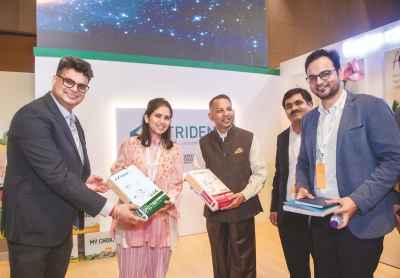
Trident Group hosted a six-day event recently, which marked as the launching pad for its new product range of a notebook series, My Choice, and revamped packaging of its existing copier paper product line. Mr. Naveet Jindal, Chief Executive Officer (CEO) of Paper, Energy & Chemicals at Trident Group India, shared with Paper Mart the idea behind the new product line, marketing strategy, sustainability efforts, and expansion plans of the company. He also provided an insightful peek into current trends in the paper industry, their impact, and best practices for the future. The company is targeting around 20 percent of capacity expansion through process optimizations at its mill.
Paper Mart: Congratulations on the launch of your new notebook product range. Kindly brief us about the idea behind venturing into the product segment.
Naveet Jindal: Thank you. So we started with our copier paper segment in 2008, and consumers have placed immense trust in Trident’s quality, service, and everything that we have offered. We have hence been able to maintain a good market share across India, with our major suppliers concentrated in the North and the NCR region. Our copier segment’s success has given us the idea to vertically integrate the notebook product series, My Choice.
Thereafter, we have a very good team of designers who work in our home textiles segment. Since My Choice is a notebook series, designing is an important part of it, for every possible customer looks for an attractive and desired design. This makes our resident designing team our USP, especially with their experience in designing for a lot of international brands.
These were the two primary thought processes that enabled us to venture into the new segment.
PM: What is your pan-India marketing strategy for the new product range?
NJ: In my opinion, Trident Group has always been quite aggressive with marketing and go-to-market (GTM) strategy. This is evident in our other product series, such as the copier paper segment, wherein we have tried to visually engage our customers with attractive packaging. I think we were almost the first ones to do so in the copier paper segment.
So we have a similarly robust marketing strategy for My Choice as well. Although we are marketing it as a brand, we are aware that it is a commodity and not a consumer good, like a mobile phone, garment, etc. We know the impact of brand is lesser in this segment as the person buying might prefer a brand, but will not delay their purchase due to non-availability. It is like bread, they will simply buy another brand. So it is a commoditized product and we cannot have huge marketing spending. So we have in place the basic marketing strategy, the 4P marketing strategy of the product, the packaging, place, and promotion.
So the product must be qualitative and that as a commodity helps the brand create its resonance. As I already mentioned, we have worked on making the packaging attractive. Thirdly, the place is very important as only its availability at the right moment will ensure a sale. Lastly, there is promotion, towards which we have this event. It is a sort of step towards a reliable and robust pan-Indian distribution network. We have called on nearly 1,000 retailers from across India, from Kargil or Leh Ladakh to Trivandrum, and from Guwahati, Meghalaya to Jaipur. We have been trying to reach out to the distributors during these six days.
So, we shall be following the basic marketing fundamentals, and I think our efforts will yield good results.
Watch: JMC Paper Tech Launches New Subsidiary JMC Papers
PM: Is the marketing strategy on the same lines for your copier paper product range?
NJ: No, it is a bit different. Firstly, the distribution channel is different, as a person selling copier paper may not have the same zeal to sell a notebook. Copier paper is often sold in wholesale boxes, whereas notebook volumes per sale are comparatively not so huge. So there is a difference in mindset. Therefore, in addition to connecting with the existing partners, we are also trying to set up an exclusive channel.
Secondly, e-commerce is not very successful for the copier segment, whereas for notebooks it can be a big game changer. So, I think these are the two aspects.
For our new product range, we are also tying up with different educational institutes. It is common for schools and institutes to have their own branding, so we are exploring opportunities along with them as well. Apart from that, we are also targeting international markets. Our presence across the US in the home textiles segment will help us to reach the US market and other global markets.
Summarily, we are not leaving any stone unturned in trying to get a deeper venture into the new market. It is also mentionable that there are very few organized players across India, and we would like to take advantage and become a recognized brand in this segment.
PM: You have also revamped the packaging of your products, especially in the copier range. Please share the changes you have made and your idea behind it.
NJ: We have been trying to contribute the best of our bit in terms of offering an eco-friendly product. About 15-16 ago we brought in the idea of making copier paper from wheat straw. At that time everybody was apprehensive, for the copier must be made from wood. However, we managed to create a success story and others followed that.
So now we have taken another step in our copier segment. We are trying to establish a message of our closeness and connection to nature by branding our new copier segment packaging through six Himalayan flowers. They are aesthetically pleasing and we believe our customers will appreciate the lively new packaging and attractive look. This will help our customers to embrace the product they are using. They will be excited to use the product they have bought. We hope they reimagine its uses by using the product not only as copier paper but also as covers for notebooks, registers, gift packaging, etc.
“We are going to launch the 65 GSM copier paper, under the EnViro brand name. We are further targeting to get into a premium range of printing paper.”
PM: Trident has always been a forerunner in innovations. Recently, which innovations have you invested in or plan to do in the future?
NJ: I think we were the first one to integrate aesthetics into the packaging, then we used the wheat straw to manufacture copier paper, which was again appreciated for not compromising on the runnability and the quality of the paper.Post-Covid-19, there has been a shift in the demand for writing and printing paper in favor of specialty segments with value-added products. Herein, paper for varied purposes is being manufactured, like wedding cards, soap stiffener paper, carry bags, cup stock, etc. The single-use plastic ban has also helped with better demand. Hence, the segment is bound to grow very quickly and we are trying to establish ourselves in it. There are a few products that we have catered to while many others are in line. We think these will help shift our percentage presence in the writing and printing segment to the value-added segments, where we can help the customers reserve good products and services.
We are also going to launch the 65 gsm copier paper, under the Enviro brand name. We are further targeting to get into a premium range of printing paper, where we would like to make our presence felt against the best in the industry.
PM: Do you have any expansion plans for your mill operations?
NJ: We have plans to optimize our current processes, which will help us increase our current production capacity. Recently, we upgraded one of our paper machines, which helped us to increase our current capacity by 10 percent. We have partnered with the best consultants available on the globe for the paper industry, and are targeting to add another 15-20 percent of capacity by optimizing the existing setup.
We are thinking of expanding for a better top line, which has been flat for the last 4-5 years. Although last year’s realizations were better because the costs were too high, the NSR increase was cost-linked. We are exploring outsourcing, collaborations, and partnerships, as even if we finalize a plant the project will take almost 3.5-4 years to become operational.
PM: Trident operates one of the biggest agro mills in the world, so sustainability has always been at the core of your business operations. Can you elaborate on your ongoing sustainability efforts?
NJ: A very important aspect and lever of our strategy is discussing what we are going to do against what we currently do. We have actually invested hugely towards sustainability, whether through optimization, saving of water, or complying and performing better than set emission norms, etc.
Recently, we put up a project where we are generating the producer gas, or methane gas, from the ETP sludge, which we use as a fuel in our energy boilers. We are currently working on handsome capex investments to target a few projects for reusing the water; decolorization of water – where water is decolorized before being reused for production or in plantations; waste-into-wealth project – where we exploring technical upgrades to process the solid waste, or sludge, generated during paper production by reducing the moisture or change the form and then making it into a good by-product that is good for everyone, has economical value and can help us preserve resources, which are quite precious these days.
So we have an undivided focus on sustainability and it is integrated into all our operations. We are trying to get in collaboration with the best so that we are future-ready.
Also Read: Kuantum Papers ESG –Sustainability beyond Manufacturing
PM: In the paper industry people often comment that our per capita paper consumption is quite low. As India now officially has the world’s largest population, what is your take on the statement and how do you foresee the future for our industry, especially for the writing and printing segment?
NJ: As per my understanding, while we used to talk about the per capita consumption earlier, that was around 8-9 kilograms, now it is about 13-14 kilograms, the world average being 57 kilograms. So, an increase of 1 kilogram per capita consumption equated with 13.5 billion of population, it is clear that there is a humongous increase in the paper demand. This demand spreads over not only writing and printing, but packaging, tissue, various specialty grades, and various industrial grades.
People are opinionated that with digitalization, writing and printing will suffer a demand decrease. However, recent studies have revealed lesser and poor quality learning through digital modes, so writing and printing might actually experience a surge. In any case, in India, for the next 10-15 years the segment will experience positive demand.
PM: What is your message or suggestion for the paper industry?
NJ: The increased imports are impacting the market and things are very tough presently. However, this is also a good time to self-evaluate ourselves for global competition, which cannot be achieved through subsidized or incentive-linked growth. We will have to become capable enough to fight our way out. Being innovative can help us in this; let us embrace the ever-changing technology. We can also work on the marketing front, as we did not predict that this event would help us establish such a profound reach pan-India within such a short time. So marketing may help the industry as well.



